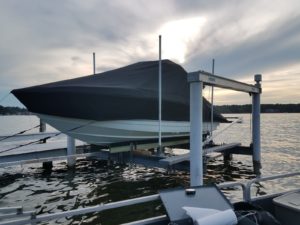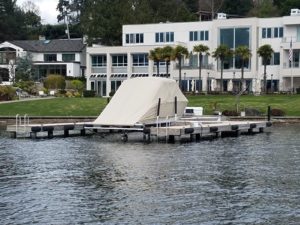High-tech tools for high-tech marine covers

digiShapes™ LLC in Kent, Wash., takes 3-D measurements of entire boats to create automatic boat covers. Photo: digiShapes.
Tim James, co-owner of digiShapes™ LLC in Kent, Wash., is a software developer with an interest in marine canvas. His company takes 3-D measurements of entire boats, which are then converted into automatic boat covers. Its SwiftShield™ system consists of a hydraulic mechanism and a tight-fitting fabric cover that is lifted up and over the boat starting at the bow and pulled toward the aft until the cover is stretched over the top. To make this work, the fabric pattern is designed to fit both the digitized model of the boat and the automatic boat cover mechanism.
“We have our own set of challenges and many of them are similar to more standard boat covers,” says James. “We’ve found that each boat may present new challenges that can affect the performance of an automatic cover. For instance, our covers rely on a hydraulic arm to deploy the cover. Screw heads [on a rub line] with burrs or sharp hardware that may not be a problem with manual covers will tear covers that are put under the loads imparted by an automatic cover. As a result, we find we must pattern each cover and use materials that allow the cover to slip on and off the boat without catching. We do this by using a 3-D scan of the boat. We then calculate the shape of the cover, then flatten it to make patterns that allow the cover to stow and deploy automatically in spite of the unusual boat geometry.”
“This brings up another major challenge, and perhaps unique to our approach: that of clear accurate measurements of each boat.” James has tried a number of existing laser-based scanners but found many cannot account for the detail and accuracy needed to fabricate covers that stretch but not catch on the aforementioned burrs or the odd hardware fitting.

To keep boat cabins free of mildew when covered, the company developed proTex™, a solution-dyed polyester fabric with a breathable, waterproof coating. Photo: digiShapes.
“We’ve developed the digiPen, which combines existing and new technologies to create an accurate and economically priced device that captures the outline of a boat in 3-D. The covers are mainly for owners of boats at higher price points who are concerned with keeping the entire boat clean and out of the sun. This includes covering hull sides, hard tops, cabins and swim platforms. Boats with cabins are not typically covered with a full cover during the boating season, and covering the boat with a non-breathable fabric causes a problem in this situation. They need powered and passive ventilation to keep the cabin free of mildew.”
For this, James and his partners developed a special fabric, proTex™, a solution-dyed polyester fabric with a breathable, waterproof coating that solves their problems. “Recent advances in breathable coating technology have allowed us to create a product with high water resistance and high breathability,” says James. “The breathability issue is no longer a problem, and the coating prevents the fabric from fraying on untreated edges.”
Bruce N. Wright is a writing consultant to architects, designers and engineers, and a frequent contributor to IFAI publications Specialty Fabrics Review, Fabric Architecture and Advanced Textiles Source.
 TEXTILES.ORG
TEXTILES.ORG 






